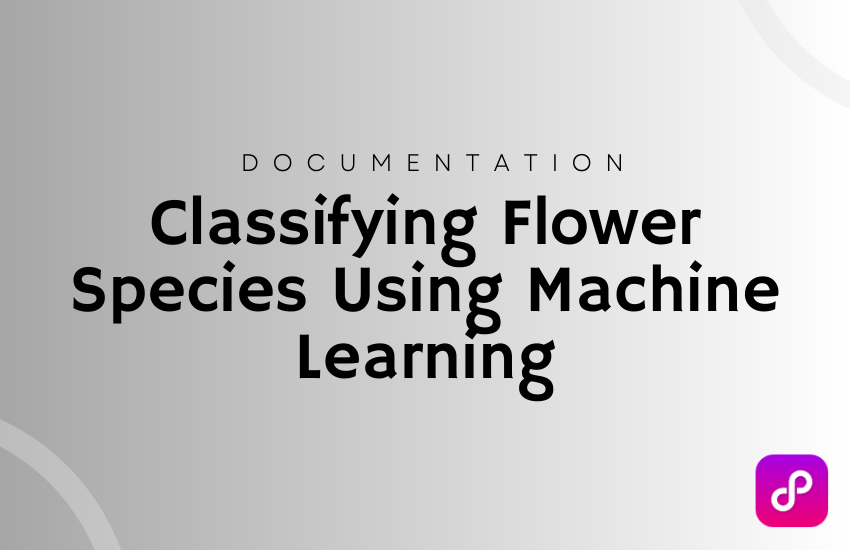
Classifying Flower Species Using Machine Learning – A Beginner’s Guide
in Machine Learning on March 11, 2025Introduction
Flowers are not just beautiful; they also have unique characteristics that distinguish them from one another. Machine learning can help classify flower species based on their sepal and petal measurements. This guide explores a Python-based Flower Species Classification Model built using Logistic Regression and the Iris dataset.
Whether you are a machine learning beginner, researcher, or botany enthusiast, this project will help you understand data visualization, preprocessing, model training, and evaluation.
Why Use Machine Learning for Flower Classification?
This project is designed to help users:
✅ Learn Supervised Machine Learning
- Understand how to train and test a model.
- Learn classification algorithms using Python and Scikit-Learn.
✅ Perform Data Analysis & Visualization
- Analyze sepal and petal characteristics using Seaborn and Matplotlib.
- Explore relationships between different flower species.
✅ Achieve High Classification Accuracy
- Uses Logistic Regression, a simple yet effective ML model.
- Provides over 95% accuracy in classifying Setosa, Versicolor, and Virginica.
✅ Build a Strong ML Portfolio Project
- Ideal for students, AI enthusiasts, and data scientists.
- Can be extended to more complex datasets.
Setting Up the Flower Classification Model
Step 1: Install Python & Jupyter Notebook
Ensure Python 3.x is installed:
pip install jupyterlab
Step 2: Install Required Libraries
Install necessary dependencies by running:
pip install seaborn pandas numpy matplotlib scikit-learn
Step 3: Download the Jupyter Notebook
Ensure the classification script (flower_classification.ipynb) is available.
Step 4: Run the Notebook
Navigate to the folder and start Jupyter Notebook:
jupyter notebook
Open flower_classification.ipynb and execute the cells sequentially.
Understanding the Iris Dataset
This project uses the Iris dataset, which consists of:
- Features: Sepal length, Sepal width, Petal length, Petal width.
- Classes:
- Setosa (Class 0)
- Versicolor (Class 1)
- Virginica (Class 2)
Checking Data Properties
data.head()
data.shape
data.species.value_counts()
This allows users to explore the dataset and class distributions.
Handling Missing Values
data.isnull().sum()
Ensures no missing values affect the training process.
Exploratory Data Analysis (EDA)
1. Visualizing Data Distributions
Scatter plots help analyze sepal and petal relationships:
plt.scatter(data['sepal_length'], data['sepal_width']);
plt.scatter(data['petal_length'], data['petal_width'], marker='o');
2. Boxplots for Outlier Detection
Boxplots display value distributions and outliers:
sns.boxplot(data['sepal_length']);
sns.boxplot(data['petal_length']);
3. Label Encoding
Convert species names into numerical labels for ML models:
def map_species(f):
if f == 'setosa':
return 0
elif f == 'versicolor':
return 1
elif f == 'virginica':
return 2
data['species'] = data.species.map(map_species)
Training the Machine Learning Model
1. Data Preprocessing & Splitting
- Normalize feature values using StandardScaler.
- Split dataset into training (75%) and testing (25%):
sc = StandardScaler()
X = sc.fit_transform(X)
X_train, X_test, y_train, y_test = train_test_split(X, y, test_size=0.25, random_state=42)
2. Training the Logistic Regression Model
lg = LogisticRegression()
lg.fit(X_train, y_train)
3. Predicting on Test Data
pred = lg.predict(X_test)
Evaluating Model Performance
1. Accuracy Score
accuracy_score(y_test, pred)
2. Classification Report
print(classification_report(y_test, pred))
3. Confusion Matrix
plt.figure(figsize=(10,5))
sns.heatmap(confusion_matrix(y_test, pred), annot=True);
This helps analyze misclassifications and performance accuracy.
Customizing the Model
This project is highly customizable! Here’s how you can enhance it:
1. Use a Different Algorithm
- Experiment with Random Forest, SVM, or KNN.
- Use Deep Learning with TensorFlow for advanced classification.
2. Improve Model Accuracy
- Tune hyperparameters using GridSearchCV.
- Increase dataset size with data augmentation techniques.
3. Add More Features
- Include color classification for more precise results.
- Use image-based classification with CNN models.
4. Convert to a Web App
- Deploy the model using Flask or Streamlit.
- Allow users to upload custom flower measurements for prediction.
Troubleshooting & Common Issues
| Issue | Solution |
|---|---|
| Notebook doesn’t open | Run jupyter notebook in the terminal. |
| Model accuracy is low | Normalize data and test different classifiers. |
| Confusion matrix shows high misclassification | Increase training data and tune hyperparameters. |
| Seaborn plots not displaying | Ensure %matplotlib inline is used in the notebook. |
Frequently Asked Questions (FAQ)
1. What does this model classify?
It predicts flower species based on sepal and petal measurements.
2. Can I use this for real-time classification?
Yes! Convert it into a Flask or Streamlit web app.
3. Can I train this model on a different dataset?
Yes, it can be retrained with any botanical dataset.
4. How accurate is the model?
It achieves over 95% accuracy with Logistic Regression.
Conclusion
The Flower Species Classification Model is a fantastic project for learning machine learning, data visualization, and model evaluation. Whether you’re a beginner, researcher, or educator, this project provides valuable ML insights and practical experience.
💡 Try it today and start classifying flowers with AI!
🔗 Download Now
Share this post!
If you found this guide helpful, share it with data science learners, researchers, and AI enthusiasts who want to explore flower classification using machine learning! 🚀
